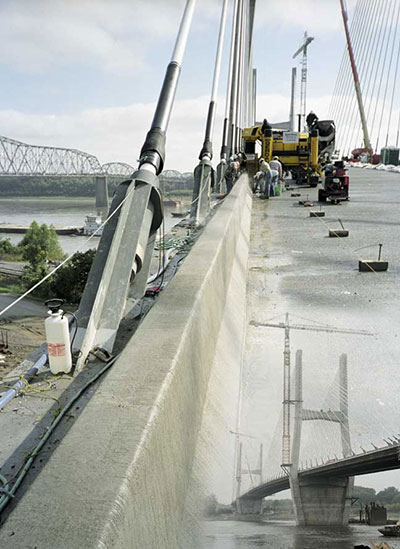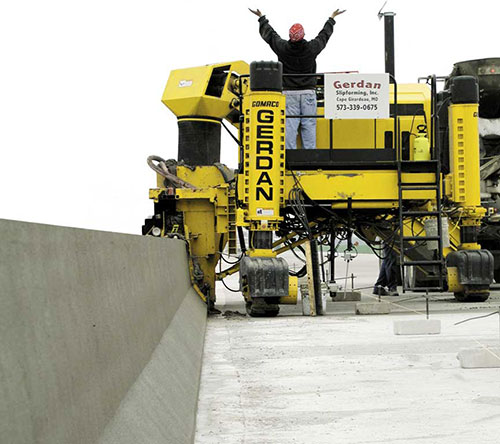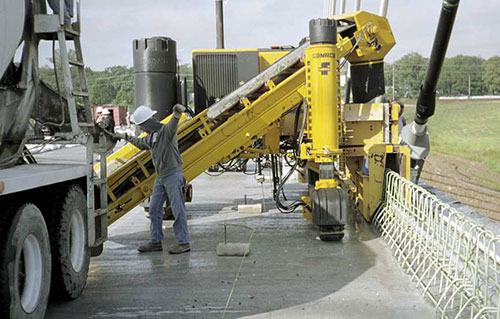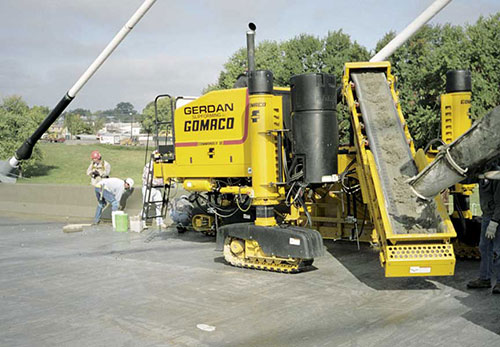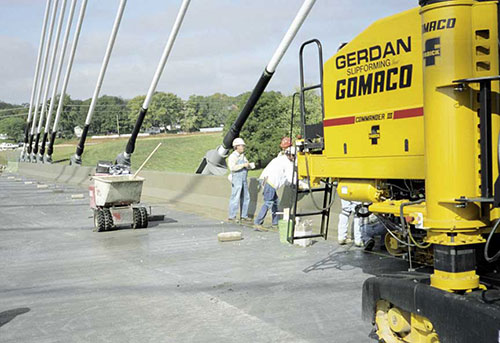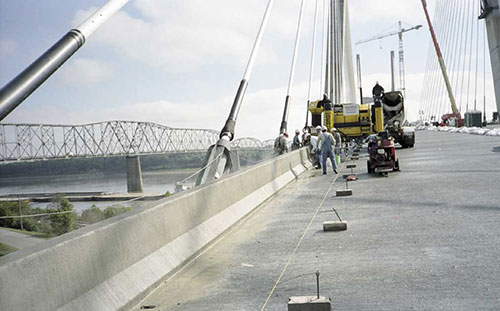GOMACO World Index --- GOMACO World 32.2 - July 2004
Slipforming Wall 60 Feet (18.3 m) Above the Mississippi River
On one of the walls in Gerdan Slipforming's office hangs a painting the company won during a silent auction for a community fund-raiser. The painting is a picturesque view of the Bill Emerson Memorial Bridge, a new suspension bridge connecting Cape Girardeau, Missouri, to East Cape Girardeau, Illinois. The painting was delivered to Gerdan Slipforming the same day they learned the company had won a bid to slipform the bridge's parapet and safety railing.
The new $100 million cable-stayed suspension bridge over the Mississippi River replaces an older bridge that could no longer handle the traffic demands of the area. The Missouri Department of Transportation (MODOT) estimates that 14,000 vehicles cross the structure daily. That estimate is expected to increase to 26,000 vehicles per day by the year 2015. The new bridge was built with that demand in mind.
The Bill Emerson Memorial Bridge is 100 feet (30.5 m) wide and stretches 4000 feet (1219 m) across the river. Thirteen million pounds (5,896,800 kg) of reinforcing steel, 171 miles (275 km) of cable, and 243,688,500 pounds (110,535,245 kg) of concrete was used to build the four-lane bridge.
The deck of the bridge is 60 feet (18.3 m) above the surface of the water. The bridge towers that hold up the support cables are another 300 feet (91.4 m) tall.
Gerdan's responsibilities on the bridge included slipforming the approximately 8500 feet (2591 m) of safety barrier and 6000 feet (1829 m) of two different styles of median barrier. The company has always been GOMACO owners and for this project they decided to purchase a new Commander III.
"I was a little leery of the new generation technology and one of my questions was, 'Am I going to have an argument with my operator about this new piece of equipment and him trying to learn it?'" Dan Driskell, project manager for Gerdan Slipforming, said. "Tom Held, my GOMACO salesman from Fabick Tractor, said the only argument that I would have between my operators was who was going to operate the new one. Tom was right."
Slipforming on the bridge began in early October 2003 on the three different types of wall. Different requirements for the approaches in the two different states created an added challenge.
"The job was bid as a MODOT project and was all done under MODOT specifications," Driskell explained. "For some reason, though, there was a different profile for the median barrier on the Illinois approach. It was actually two safety barriers with a seven inch (178 mm) top and 16 inch (406 mm) base with a four inch (102 mm) gap in between the two."
The Missouri-approach median barrier is 18 inches (457 mm) wide at the top, 36 inches (914 mm) at the base and 34 inches (864 mm) tall. A third profile, the safety barrier, measured 10.75 inches (273 mm) wide on top and 20 inches (508 mm) across the bottom.
The concrete for the walls was a MODOT B1, 6.73 bag mix with air entrainment. Slump averages between .75 and one inch (19 and 25 mm).
"The machine started out picture perfect and just kept on going," Driskell said. "Our finisher foreman, Chris Markham, told me he felt like he was stealing money from me. He said the finish on the wall is coming out so smooth and the machine is doing such an excellent job, the finishers have very, very little to do."
All the finishers had to do was apply a light broom finish to the wall and cut the joints in. Once again, the two states had different requirements for the approaches. On the Missouri side, joints were saw cut in one inch (25 mm) deep, every 35 feet (10.7 m). On the Illinois approach, joints were every 10 feet (3 m).
"This project went very smooth for us and the machine has been picture perfect," Driskell said. "We poured approximately 1100 feet (335 m) of the 18 inch (457 mm) wide median barrier per day on the bridge."
The Bill Emerson Memorial Bridge was opened and operational by December 2003. Gerdan has moved on to their next projects but regardless of where they're working or what they may be slipforming on, the company has certain guidelines they follow to ensure success.
"There are so many variables when pouring barrier wall that it's like a snowball effect, one has to work before the other one will," Driskell explained. "First and foremost, if your machine is not set up correctly, you're not going to get a good product out of the machine. Setting the machine up is foremost important and you have to have the knowledge to set the machine up or someone with experience to show you how. The mix design and the slump of the concrete can make or break the project and give you a good job or not. The other important factor is your operator. If you have an experienced operator who knows about pouring wall, then things go pretty smoothly."
Gerdan is used to working on bridges. In the company's 13-year history, they have specialized in not only curb and gutter, but bridge parapet and median barrier. Slipforming on a suspension bridge, though, was a new experience for the company, one that they are more than willing to tackle again.
"Suspension bridges don't require us to change how we approach the work that we do on them. It's just interesting and amazing to listen to the facts associated with them and the engineering involved," Driskell said. "One fact that I found interesting... by the time the three inch (76 mm) concrete surface is poured over the precast panels and we slipform the two outside barriers and the median barrier on the bridge, the center of the cable span bridge will be two feet (0.6 m) lower than before those concrete items were put on it."
Bridge Facts:
* The new bridge has four lanes of traffic and is five times wider than the old one
* 140 lights illuminate the white cables at night
* The bridge deck is 60 feet (18.3 m) above the water while the towers that hold the support cables are another 300 feet (91.4 m) above the deck
Constructing the bridge consumed:
* 13 million pounds (5,896,800 kg) of reinforcing steel
* 171 miles (275 km) of cable
* 243,688,500 pounds (110,535,245 kg) of concrete
* 15 million pounds (6,804,000 kg) of steel beams
Subscribe to Receive GOMACO World Magazine
